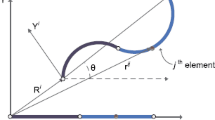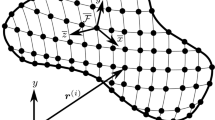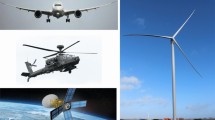Abstract
One important issue for the simulation of flexible multibody systems is the reduction of the flexible body’s degrees of freedom. In this work, nonmodal model reduction techniques for flexible multibody systems within the floating frame of reference framework are considered. While traditionally in the multibody community modal techniques in many different forms are used, here other methods from system dynamics and mathematics are in the focus. For the reduction process, finite element data and user inputs are necessary. Prior to the reduction process, the user first needs to choose boundary conditions fitting the chosen reference frame before defining the appropriate in- and outputs. In this work, four different possibilities of modeling appropriate interface points to reduce the number of inputs and outputs are presented.
The main model reduction techniques to be considered in this context are moment-matching by projection on Krylov-subspaces, singular vaule decomposition (SVD)-based reduction techniques and combinations of those which are also compared to traditional modal approaches. All these reduction techniques are implemented in the model order reduction code Morembs. In addition, an error estimator for Krylov-subspace methods exists and an a-priori error bound can be calculated if frequency weighted Gramian matrices are used for the reduction process. This allows a fully automated reduction process. We evaluate and compare these methods in the frequency as well as in the time domain by reducing the flexible degrees of freedom of a rack used for active vibration damping of a scanning tunneling microscope.
Similar content being viewed by others
References
Schwertassek, R., Wallrapp, O.: Dynamik flexibler Mehrkörpersysteme. Vieweg, Braunschweig (1999) (in German)
Shabana, A.A.: Dynamics of Multibody Systems. Cambridge University Press, Cambridge (1998)
Wu, S.-C., Haug, E.J., Kim, S.-S.: A variational approach to dynamics of flexible multibody systems. Mech. Struct. Mach., 17, 3–32 (1989)
Cardona, A., Géradin, M.: A superelement formulation for mechanism analysis. Comput. Methods Appl. Mech. Eng. 100, 1–29 (1992)
Schwertassek, R., Wallrapp, O., Shabana, A.: Flexible multibody simulation and choice of shape functions. Nonlinear Dyn. 20, 361–380 (1999)
Wallrapp, O., Wiedemann, S.: Comparison of results in flexible multibody dynamics using various approaches. Nonlinear Dyn. 34, 189–206 (2003)
Craig, R., Bampton, M.: Coupling of substructures for dynamic analyses. AIAA J. 6, 1313–1319 (1968)
Wallrapp, O.: Standardization of flexible body modeling in multibody system codes, Part I: Definition of standard input data. Mech. Struct. Mach. 22, 283–304 (1994)
Lehner, M., Eberhard, P.: A two-step approach for model reduction in flexible multibody dynamics. Multibody Syst. Dyn. 17, 157–176 (2007)
Fehr, J., Eberhard, P., Lehner, M.: Improving the reduction process in flexible multibody dynamics by the use of 2nd order position Gramian matrices. In: Proceedings 6th EUROMECH Nonlinear Dynamics Conference, St. Petersburg, Russia (2008)
Lu, J., Ast, A., Eberhard, P.: Modeling and active vibration control of flexible structures using multibody system theory. In: Proceedings of ICMEM, Wuxi, China (2007)
Nikravesh, P.E., Lin, Y.-S.: Use of principal axes as the floating reference frame for a moving deformable body. Multibody Syst. Dyn. 13, 211–231 (2005)
Heckmann, A.: On the choice of boundary conditions for mode shapes in flexible multibody systems. Multibody Syst. Dyn. 23, 141–163 (2010)
Release 11.0 Documentation for Ansys. http://www.ansys.com (2009)
Dresig, H., Holzweißig, F.: Maschinendynamik, vol. 5. Springer, Berlin (2004) (in German)
Bavely, C.A., Stewart, G.W.: An algorithm for computing reducing subspaces by block diagonalization. SIAM J. Numer. Anal. 16, 359–367 (1979)
Lehner, M.: Modellreduktion in elastischen Mehrkörpersystemen. In: Dissertation, Schriften aus dem Institut für Technische und Numerische Mechanik der Universität Stuttgart, vol. 10. Shaker, Aachen (2007) (in German)
MSC.Software Corporation: Theoretical Background of ADAMS/Flex, Part of the ADAMS/Flex Training Course, 2003rd ed. MSC Software, Santa Ana (2003)
Antoulas, T.C.: Approximation of Large-Scale Dynamical Systems. SIAM, Philadelphia (2005)
Salimbahrami, B., Lohmann, B.: Order reduction of large scale second-order systems using Krylov subspace methods. Linear Algebra Appl. 415, 385–405 (2006)
Stykel, T.: Balanced truncation model reduction of second-order systems. In: Troch, I., Breitenecker, F. (eds.) 5th Vienna Symposium on Mathematical Modelling, Vienna (2006)
Bai, Z.: Krylov subspace techniques for reduced-order modeling of large-scale dynamical systems. Appl. Numer. Math. 43, 9–44 (2002)
Beattie, C.A., Gugercin, S.: Krylov-based model reduction of second-order systems with proportional damping. In: 44th IEEE Conference on Decision and Control, 2005 European Control Conference, pp. 2278–2283 (2005)
Han, J.S., Rudnyi, E.B., Korvink, J.: Efficient optimization of transient dynamic problems in MEMS devices using model order reduction. J. Micromech. Microeng. 15, 822–832 (2005)
Gawronski, W.K.: Advanced Structural Dynamics and Active Control of Structures. Springer, New York (2004)
Salimbahrami, S.B.: Structure preserving order reduction of large scale second order models. Ph.D. Thesis, Technische Universität München (2005)
Bai, Z., Slone, R., Smith, W., Ye, Q.: Error bound for reduced system model by Pade approximation via the Lanczos process. IEEE Trans. Comput.-Aided Des. Integr. Circuits Syst. 18, 133–141 (1999)
Gugercin, S., Antoulas, A.C., Beattie, C.A.: \(\mathcal{H}_{2}\) model reduction for large-scale linear dynamical systems. SIAM J. Matrix Anal. Appl. 30, 609–638 (2008)
Eid, R., Salimbahrami, B., Lohmann, B.: Equivalence of Laguerre-based model order reduction and moment matching. IEEE Trans. Autom. Control 52, 1104–1108 (2007)
Eid, R.: Time Domain Model Reduction by Moment Matching. Dr. Hut, München (2009)
Chu, C.-C., Lai, M.-H., Feng, W.-S.: MIMO Interconnects order reductions by using the multiple point adaptive-order rational global Arnoldi algorithm. IEICE Trans. Electron. E89-C, 792–802 (2006)
Fehr, J., Eberhard, P.: Error-controlled model reduction in flexible multibody dynamics. J. Comput. Nonlinear Dyn. 5, 031005 (2010)
Heyouni, M., Jbilou, K.: Matrix Krylov subspace methods for large scale model reduction problems. Appl. Math. Comput. 181, 1215–1228 (2006)
Grimme, E.J.: Krylov projection methods for model reduction. Ph.D. Thesis, University of Illinois at Urbana-Champaign (1997)
Konkel, Y., Farle, O., Dyczij-Edlinger, R.: Ein Fehlerschätzer für die Krylov-Unterraum basierte Ordnungsreduktion zeitharmonischer Anregungsprobleme. In: Lohmann, B., Kugi, A. (eds.) Tagungsband GMA-Fachausschuss 1.30 “Modellbildung, Identifikation und Simulation in der Automatisierungstechnik”, VDI/VDE-GMA, Technische Universität Wien, Institut für Automatisierungs- und Regelungstechnik, Salzburg (2008) (in German)
Laub, A.J., Laub, A.J., Heath, M.T., Paige, C.C., Ward, R.C.: Computation of system balancing transformations. In: 25th IEEE Conference on Decision and Control, Athens, Greece, pp. 548–553 (1986)
Enns, D.: Model reduction with balanced realizations: an error bound and a frequency weighted generalization. In: Proceedings of the 23rd IEEE Conference on Decision and Control, Las Vegas, 1984, pp. 127–132. IEEE, New York (1984)
Chahlaoui, Y., Lemonnier, D., Vandendorpe, A., Dooren, P.V.: Second-order balanced truncation. Linear Algebra Appl. 415, 378–384 (2006)
Reis, T., Stykel, T.: Balanced truncation model reduction of second-order systems. Math. Comput. Model. Dyn. Syst. 14, 391–406 (2008)
Benner, P., Saak, J.: Efficient balancing based MOR for second order systems arising in control of machine tools. In: Troch, I., Breitenecker, F. (eds.) Proceedings of the MathMod 2009 (2009)
Kruszinski, L.: Implementierung und Test neuer Methoden zur Approximation des dominanten Eigenraums von Gramschen Matrizen 2ter Ordnung. Thesis DIPL-130, Institute of Engineering and Computational Mechanics, University of Stuttgart (2008) (in German)
Gasch, R., Knothe, K.: Strukturdynamik Band 2—Kontinua und ihre Diskretisierung (in German). Springer, Berlin (1989)
Gawronski, W.K.: Dynamics and Control of Structures—a Modal Approach. Springer, Berlin (1998)
Dietz, S.: Vibration and Fatigue Analysis of Vehicle Systems Using Component Modes. Fortschritt-Berichte VDI, reihe 12(401). VDI, Düsseldorf (1999)
Graig, R.R.J.: Structural Dynamics. Wiley, New York (1981)
Koutsovasilis, P., Beitelschmidt, M.: Comparison of model reduction techniques for large mechanical systems. Multibody Syst. Dyn. 20, 111–128 (2008)
Dickens, J.M., Nakagawa, J.M., Wittbrodt, M.J.: A critique of mode acceleration and modal truncation augmentation methods for modal response analysis. Comput. Struct. 62, 985–998 (1997)
Author information
Authors and Affiliations
Corresponding author
Rights and permissions
About this article
Cite this article
Fehr, J., Eberhard, P. Simulation process of flexible multibody systems with non-modal model order reduction techniques. Multibody Syst Dyn 25, 313–334 (2011). https://doi.org/10.1007/s11044-010-9238-3
Received:
Accepted:
Published:
Issue Date:
DOI: https://doi.org/10.1007/s11044-010-9238-3




